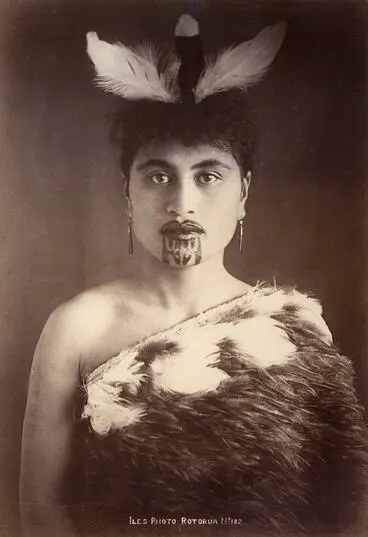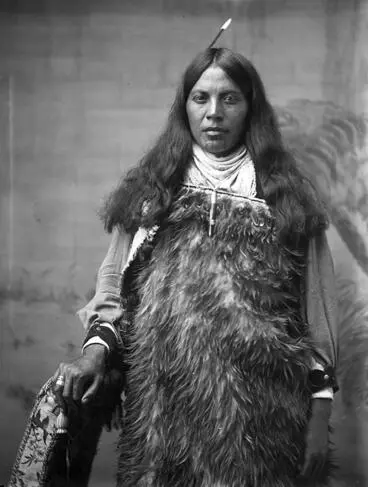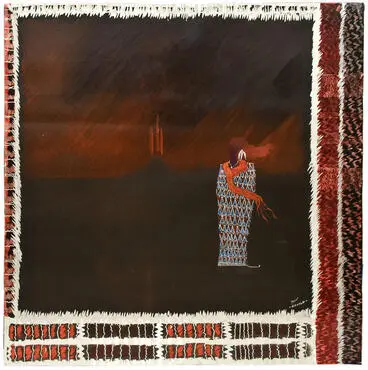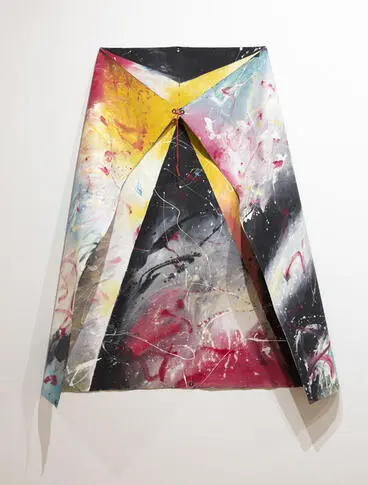Kahu kiwi: Tuia Mātauranga Curiosity Card
A DigitalNZ Story by National Library Services to Schools
Queen Elizabeth and the Duke of Edinburgh wearing kahu kiwi (cloaks made with kiwi feathers) during their visit to Aotearoa New Zealand in 1986.
BACKGROUND
Māori always regarded the kiwi as a special bird. They knew it as ‘te manu huna a Tāne’, the hidden bird of Tāne, god of the forest. Kiwi feather cloaks (kahu kiwi), originally made by sewing kiwi skins together, were taonga (treasures) usually reserved for chiefs. Kiwi feathers, now woven into flax cloaks, are still valued. In traditional Māori thought, many birds were seen as chiefly. The feathers of certain birds were used as adornment for high-born people – particularly plumes worn in the hair. Chiefs wore the kahu huruhuru (feather cloak), made from the feathers of the most beautiful birds. The kiwi was known as ‘te manu huna a Tāne’, the hidden bird of Tāne (god of the forest), because it came out mostly at night and was seldom seen. Kiwi meat was considered fit for chiefs. Their feathers were woven into rare, beautiful cloaks called kahu kiwi, which were considered taonga (treasures). The cloaks are used on special ceremonial occasions, such as the tangi (funeral) in August 2006 of the Māori queen, Te Arikinui Dame Atairangikaahu.
He wāhi nui tō ngā manu i roto i te ao Māori, hei kai, ko ōna huruhuru hei kura whakarākai i te tinana me ngā kākahu o te rangatira. Ka āta mātaki te Māori i ngā whanonga me te noho a tēnā manu, a tēnā manu. Kei ngā mōteatea me ngā whakataukī ngā momo manu e whakahuatia ana. Ka tirohia te whanonga o te manu mō ngā tohu huarere me ngā tohu mō ngā rā kei te tū.
He tohu rangatira
E ai ki te Māori ko ētahi manu ka tohu ki te rangatiratanga. Ko ngā huruhuru o ētahi manu hei whakarākai i te māhunga o te ariki, o te rangatira. Kākahungia ai te rangatira ki ngā kākahu ka whatua i ngā huruhuru o ngā manu ātaahua rawa atu. Kīia ai te kiwi ko ‘te manu huna a Tāne’, nā te mea hei ngā pō anake ka puta tēnei manu. He kai nā te rangatira te kiwi. Whatua ai te kahu kiwi i ōna huruhuru, he taonga kura. Hei ngā hui nui o te ao Māori ka kitea ēnei kākahu, pērā i te tangihanga mō te kūini Māori a Te Ātairangikaahu i te marama o Here-turi-kōkā i te tau 2006.
Kiwi
Source: 'Kiwi - Kiwi and people: early history', URL: http://www.teara.govt.nz/en/kiwi/page-4, (Ministry for Culture and Heritage), (updated 15-May-2015)
Symbols of status
Source: ‘Ngā manu – birds', URL: http://www.teara.govt.nz/en/nga-manu-birds, (Ministry for Culture and Heritage), (updated 17-February-2015)
Nga Manu
Source: 'Ngā manu', URL: http://www.teara.govt.nz/mi/nga-manu, (Ministry for Culture and Heritage), (updated 17-February-2015)
Kahu kiwi (kiwi feather cloak)
Museum of New Zealand Te Papa Tongarewa
Kahu kiwi (kiwi feather cloak)
Museum of New Zealand Te Papa Tongarewa
Kahu kiwi (kiwi feather cloak)
Museum of New Zealand Te Papa Tongarewa
Complexity
Clothing conveyed a range of information about the status of the wearer and the region they were from. However, because Māori society had a communal nature, there was a strong sense of collective identity. If the leader of a group was well dressed, it reflected on all members. The most prestigious garments were labour-intensive in construction, incorporating rare or valued elements. They were worn only by those with high status and power. However, the relationship between dress and mana was highly complex. Dressing well served to add mana to certain activities – ranging from the peacetime planting of kūmara to preparing for battle. Men involved in the ceremonial planting of kūmara plots on the East Coast were required to be clothed in garments such as the aronui, māhiti, paepaeroa, puhoro or pātea – all finely woven garments of dressed flax, differing from one another in their ornamentation. This was part of creating the most auspicious conditions to ensure a successful harvest.
Extending personal mana
For people of high rank, items of dress could serve as extensions of the owner’s personal power or mana. A chiefly garment, or even part of it, could be used to set something aside for exclusive use, signifying a type of potential ownership. An early Pākehā-Māori recorded how a chief had ‘reserved’ a gun that he fancied: ‘“I must tapu it before I leave the ship.“ … here he pulls a piece of the fringe from his cloak and ties it round the stock of the gun, thereby rendering it impossible for me to sell, give away, or dispose of it in any way to anyone but himself.’
Ngā uauatanga
Kei ngā kākahu ka mōhiotia te mana o te tangata me te rohe i ahu mai ia. Nā te noho kotahi o te tangata, kei te āhua tonu o te rangatira te mana o te iwi e pupuri ana. Ko ngā tino kākahu ko ērā i roa te whatunga mai, i rākaitia hoki ki ngā tongarerewa ongeonge. Mā ngā rangatira anake ēnei momo kākahu. Arā tonu ngā momo kākahu mō te aiō, te whakatō kūmara me te whakatakataka taua. Ko te mahi a ngā tāne o Te Tai Rāwhiti i te whakatōnga o te kumara, he mau i ngā kākahu rangatira pērā i te aronui, te māhiti, te paepaeroa, te pūhoro me te pātea. Ko te tikanga o tēnei, kia rangatira rawa ai te mahi e whai hua ai i te hauhake.
Te whakatoro i te mana tangata
Ka whakamahi anō ngā rangatira i ō rātou kākahu hei whakatau i tōna mana. Ka whakamahia te korowai, tētahi wāhanga rānei o te korowai hei taunaha i tētahi mea. I tētahi o ngā tūtakinga tōmua a te Pākehā me te Māori, ka taunaha tētahi rangatira i tētahi pū mōna: Me whakatapu rawa au i tēnei pū māku i mua i taku wehenga i tēnei kaipuke. ‘’ … i konei ka hūtia e ia tētahi hukahuka o tōna korowai, ā, ka herea ki te pū. Nō konei kua kore e taea e au te hoko atu taua pū ki tētahi atu tangata.’
Traditional Māori dress
Source: 'Māori clothing and adornment – kākahu Māori', URL: http://www.teara.govt.nz/en/maori-clothing-and-adornment-kakahu-maori, (Ministry for Culture and Heritage), (published 5-September-2013)
Ngā taonga tuku iho
Source: 'Kākahu Māori', URL: http://www.teara.govt.nz/mi/kakahu-maori, (Ministry for Culture and Heritage), (published 5-September-2013)
Korowai Whakahekeheke
Museum of New Zealand Te Papa Tongarewa
Kahu kiwi (kiwi feather cloak) named Piata
Museum of New Zealand Te Papa Tongarewa
Kahu kiwi (kiwi feather cloak)
Museum of New Zealand Te Papa Tongarewa
QUICK FACTS
- In a Māori curio auction in London in 1912, a kahu kiwi cloak made of finely dressed flax (muka) and covered with kiwi feathers fetched, £l6.
- A Māori legend relates that after Mataora visited the spirit world he brought back the art of tattooing, and also a famous cloak and belt known as Te Rangi Haupapa and Te Ruruku-o-te-rangi. These were used as garments making patterns ever since.
- In 2018 New Zealand Prime Minister Jacinda Ardern wore a traditional Māori cloak, a kahu huruhuru (feather cloak), to a Commonwealth heads of government dinner in London after she met with Queen Elizabeth II.
- Prestige cloaks were not only worn for protection and warmth but also symbolised the wearer's mana or status.
- There might be 6,000 feathers woven into a single feather cloak (kahu huruhuru). One Māori cloak in Te Papa’s collection has more than 12,000 feathers in it.
- Some Hawaiian feather cloaks were made from the feathers of more than 18,000 birds.
Kahu huruhuru (feather cloak)
Museum of New Zealand Te Papa Tongarewa
Kahu huruhuru (feather cloak)
Museum of New Zealand Te Papa Tongarewa
Kahu huruhuru (feather cloak)
Museum of New Zealand Te Papa Tongarewa
Dogskin cloak
Manatū Taonga, the Ministry for Culture and Heritage
Cloak
Museum of New Zealand Te Papa Tongarewa
OTHER RESOURCES
Feathers — Māori weavers used feathers to adorn cloaks, creating prestigious kahu huruhuru.
Feather signatures — Researcher Hokimate Harwood puts feather cloaks under the microscope, with surprising results.
Hawaiian feather cape presented to Captain Cook — feathered capes were highly significant to Hawaiians because they were seen as symbols of rank and status.
Identifying feathers — Hokimate Harwood, Te Papa’s Bicultural Science Researcher, is breaking new ground in her research on kahu huruhuru (feather cloaks).
Kahu ora — He pae tukutuku Youtube, he kohinga kiriata e pā ana ki ngā kahu Māori.
Kakahu, Māori Cloaks — Te Papa houses the world’s largest collection of Māori cloaks – more than 300 in total, both customary and contemporary.
Kiwi and people: early history — Māori always regarded the kiwi as a special bird.
Kōrero kākahu — Veranoa Hetet and her group of weavers.
Korowai — images of old and contemporary korowai.
Ngā pueru – prestige garments — prestige cloaks are fit for wearing by people of authority.
NZ Golf’s so-called ‘korowai’ cloak — the cloak that draped a victorious golfer's shoulders is made from faux fur and is not a handmade feather korowai.
The Feather Cloak of Captain Cook — when Captain Cook landed on Hawaii, the island’s high chief literally gave the cloak off his back to the British navigator.
The symbolic meaning of kākahu — insights into the symbolic significance of woven garments such as kākahu (cloaks).
Tirikātene family kahu kiwi — successive members of the Tirikātene family of Ngāi Tahu have worn the treasured kahu kiwi (kiwi-feather cloak)
Weaving a korowai — a video of korowai weaving.
Four Maori girls
Museum of New Zealand Te Papa Tongarewa
Rawinia and Ripipete - Photograph taken by William Henry Thomas Partington
Alexander Turnbull Library
Portrait of an unidentified Maori man from the Wanganui region
Alexander Turnbull Library
Maori woman, New Zealand, c.1891-1930
Museums Victoria
Ross, Malcolm, 1862-1930 :Young men of Tuhoe land, in flax and feather mats
Alexander Turnbull Library
Miriama Ngaiwaea
Puke Ariki
Bishop Brian Tamaki
Manatū Taonga, the Ministry for Culture and Heritage
Photograph of Whina Cooper in Hamilton during the Māori Land March
Alexander Turnbull Library
Tirikātene family kahu kiwi
Manatū Taonga, the Ministry for Culture and Heritage
FERTILE QUESTIONS
- He aha e whakaarotia ai, he taonga te kahu kiwi?
- What messages can clothes send?
- Mā wai te tangata e whakamana?
- How has what we wear changed over time?
- He here tō te taonga?
- How might gifts be conditional?
- What is your question?
[Merrett, Joseph Jenner] 1815-1854 :[Four Maori girls and one young Maori man. ca. 1846]
Alexander Turnbull Library
[Merrett, Joseph Jenner] 1815-1854 :Johny Heke & wife [ca 1845]
Alexander Turnbull Library
Evening cloak
Museum of New Zealand Te Papa Tongarewa
Cloak
Museum of New Zealand Te Papa Tongarewa
Cloak
Museum of New Zealand Te Papa Tongarewa
ADDITIONAL QUESTIONS
- What is mana? How can it be expressed?
- Is there a link between the value of a gift and the status of the giver/receiver?
"Ancestor of Taranaki"
Puke Ariki
‘Ko Tararua 5’
Manatū Taonga, the Ministry for Culture and Heritage
"Grey Cloak (for Edward)"
Te Whare o Rehua Sarjeant Gallery
This story was curated and compiled by Te Puna Mātauranga o Aotearoa | National Library of New Zealand, Services to Schools staff, 2019.







